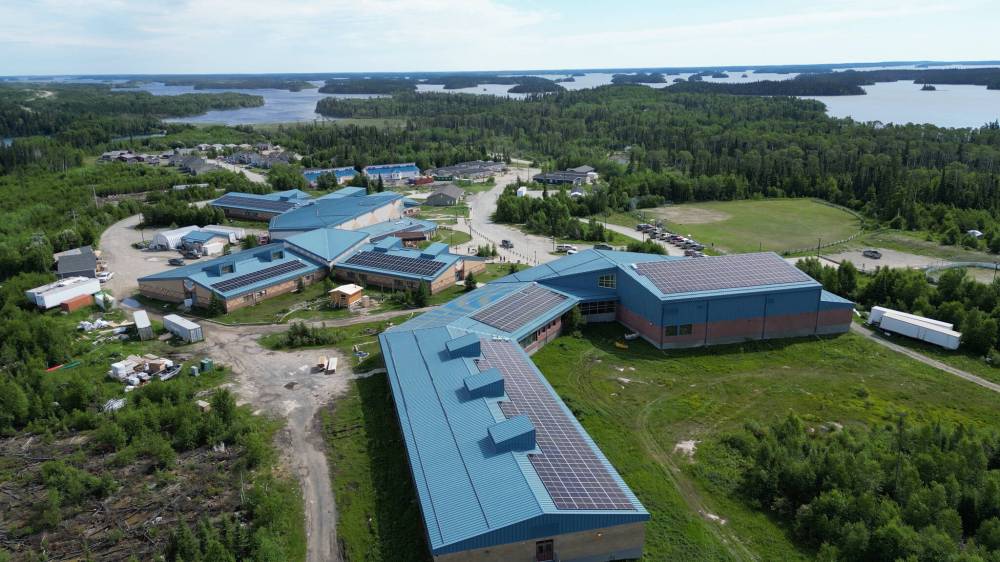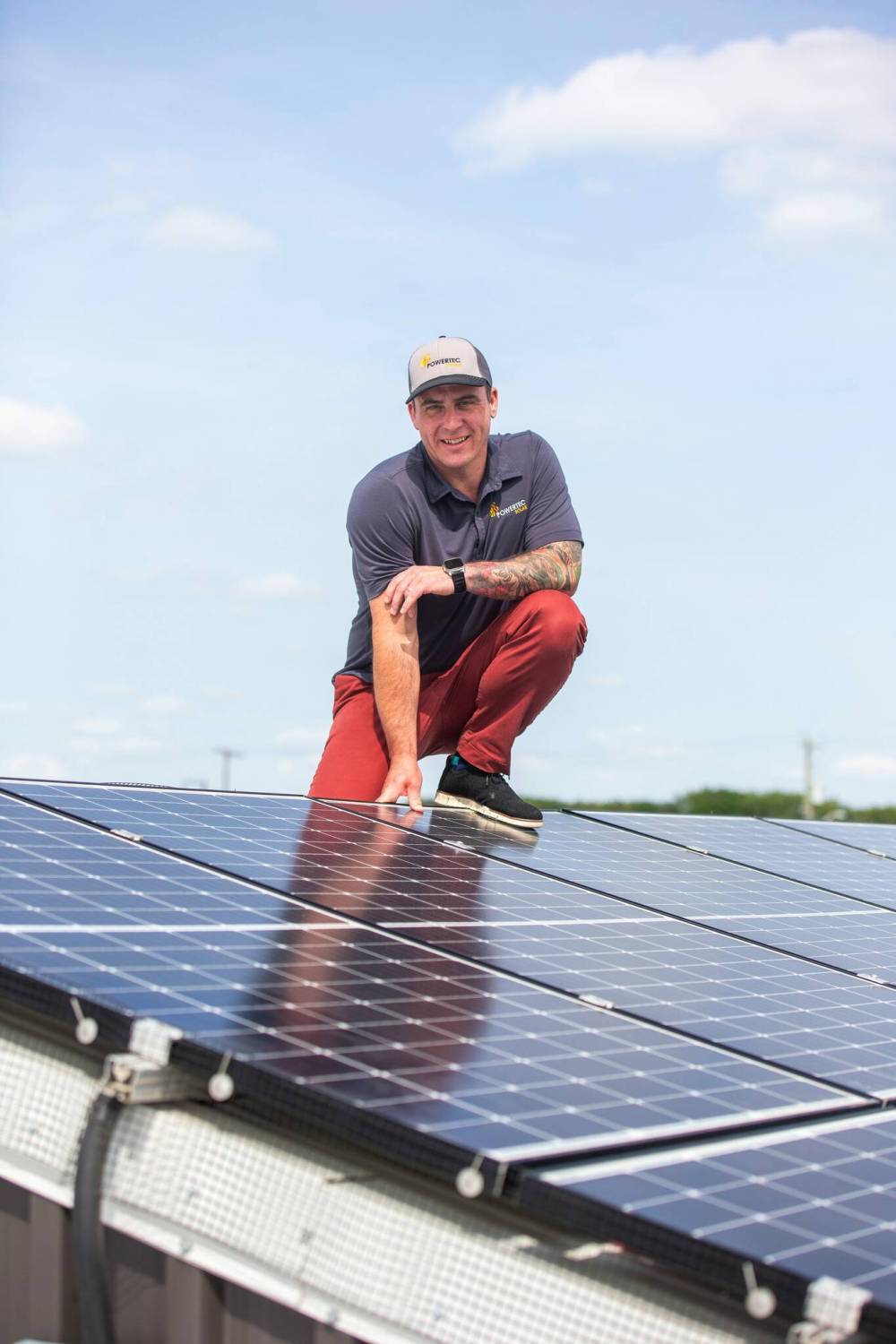St. Theresa Point schools get solar power
First Nation benefits from federal government’s Green and Inclusive Community Buildings program
Advertisement
Read this article for free:
or
Already have an account? Log in here »
To continue reading, please subscribe:
Monthly Digital Subscription
$0 for the first 4 weeks*
- Enjoy unlimited reading on winnipegfreepress.com
- Read the E-Edition, our digital replica newspaper
- Access News Break, our award-winning app
- Play interactive puzzles
*No charge for 4 weeks then price increases to the regular rate of $19.00 plus GST every four weeks. Offer available to new and qualified returning subscribers only. Cancel any time.
Monthly Digital Subscription
$4.75/week*
- Enjoy unlimited reading on winnipegfreepress.com
- Read the E-Edition, our digital replica newspaper
- Access News Break, our award-winning app
- Play interactive puzzles
*Billed as $19 plus GST every four weeks. Cancel any time.
To continue reading, please subscribe:
Add Free Press access to your Brandon Sun subscription for only an additional
$1 for the first 4 weeks*
*Your next subscription payment will increase by $1.00 and you will be charged $16.99 plus GST for four weeks. After four weeks, your payment will increase to $23.99 plus GST every four weeks.
Read unlimited articles for free today:
or
Already have an account? Log in here »
Hey there, time traveller!
This article was published 12/07/2023 (849 days ago), so information in it may no longer be current.
The Island Lake community of St. Theresa Point just fired up a 350-kilowatt solar power system that will provide power for all three of its schools.
Chief Elvin Flett has a lot to manage leading a community of close to 5,000 residents more than 600 kilometres north of Winnipeg, where there are no all-season road connections.
But he figures the opportunity to do something progressive like this will be a source of community pride.

SUPPLIED
Aerial photo of St. Theresa Point First Nation schools powered by solar panels.
“Definitely, saving money from Manitoba Hydro is a big factor,” he said. “I wouldn’t necessarily say we’re being pioneers, but we wanted to see how it affects us overall.”
It took a few years of planning and scoping out the best project to install according to the rebates and tax credits available from the provincial and federal governments.
Working with Winnipeg-based PowerTec Electric Inc. since 2018, the community successfully applied for $1.5 million of funding from the federal government’s Green and Inclusive Community Buildings program.
While Chief Flett said the community’s staffers did not have too hard a time doing the funding application, it still took a couple of years to complete.
For one thing, the equipment had to be shipped up to the community during the short winter road shopping season in the winter of 2022.
That meant the material had to sit for about a year before the installation was able to be completed this spring and early summer.
Daniel Hartley, the president of PowerTec, said a project of this size would not receive funding without strong leadership from the community.
“We helped when our assistance was required, but it has to be community-driven,” he said. “This is their project not ours.”
St. Theresa Point was connected to the Manitoba Hydro power grid in 1990s and all 600-plus residences on the reserve are now connected and no longer have to rely on inferior diesel generators, but Flett said any time they can save money on their Hydro expenses the better.

SUPPLIED
Chief Elvin Flett pulling the switch on a new $1.5 million solar array that will power the community’s schools.
“It will help us to move a little closer to be able to enjoy the standard of living of the people in the south,” he said. “Yes our homes are all connected to Hydro, but the homes are not the highest quality.”
The solar arrays sit on the rooftops of elementary, middle and high schools. The schools are only about 20 years old, but Flett said they are overcrowded and could use an additional 35 classrooms.
Hartley figures the system ought to be able to save the community about $50,000 per year, which is money that can be put towards the educational budget.
Flett said they’re going to wait at least a year to see what kind of benefits are achieved.
“If it’s successful we will continue to look for other avenues to expand solar panels in the schools and maybe other buildings like band office and nursing station,” he said.
Funding from the federal program meant the community did not have to go out of pocket for the green energy project.
The $1.5 billion Green and Inclusive Community Buildings program was almost tailor-made for the St. Theresa Point schools. It was designed to support green and accessible retrofits of existing public community buildings and the construction of new publicly-accessible community buildings that serve high-needs, under-served communities across Canada.
Manitoba is not a hotbed of solar power generation largely because of the province’s abundant, cheap, green hydroelectricity. But even still, Hartley said the combination of rebates and tax credits has never been better in Manitoba.
But because of this province’s Hydro advantage his 75-person company — which also does plenty of conventional commercial and residential electrical work — has had to go further afield to Nunavut, Ontario and Saskatchewan for a lot of its solar work.

MIKAELA MACKENZIE / WINNIPEG FREE PRESS
Daniel Hartley, the president of PowerTec, said a project of this size would not receive funding without strong leadership from the community.
But he believes there is also growing demand in Manitoba.
“We’ve got about 200 residential projects on the go right now,” he said.
That said, the St. Theresa Point project would not have been economically viable without the federal funding. Hartley still believes that with the funding support it can be a money-saving project even accounting for shipping equipment that far north on winter roads and three months worth of installation construction.
The project included training for some community members, as there are a number of licensed electricians already in the community. That and the fact that solar arrays generally do not require a lot of maintenance, means they are suitable for communities as isolated as St. Theresa Point.
martin.cash@freepress.mb.ca

